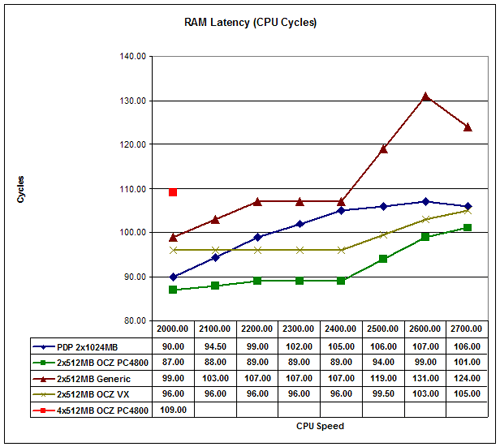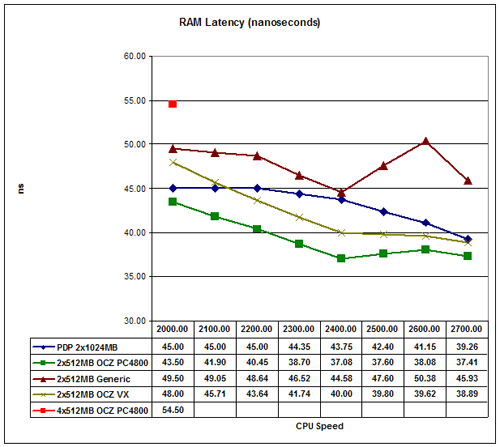Investigations into Athlon X2 Overclocking
by Jarred Walton on December 21, 2005 12:00 PM EST- Posted in
- CPUs
RAM Latency
In the Venice article, we talked quite a bit about memory latencies and how they affect performance. Since we're using four different types of RAM this time, we will most likely see more variation in RAM latencies. However, even a relatively large difference of 20% will often have less than a 5% impact on real world application performance. Another item to pay attention to is the difference between higher bandwidth vs. lower latencies that the OCZ VX and EL Platinum represent.
CPU-Z includes a latency.exe program that we used to get these values, and we selected the score in the bottom-right of the table. This position represents a 32MB data set with a 512 KB stride size, and the results are reported in CPU cycles. We have two charts again, the first in CPU cycles and the second in nanoseconds. Since cycle time decreases as clock speed increases, we would pay a bit more attention to the results in nanoseconds. However, the elapsed CPU cycles are also important as they represent wasted CPU time. If cache misses are relatively constant - and they are - then the higher the RAM latency is in CPU cycles, the less efficient the processor becomes. Here are the results.
Since all of the various configurations ran successfully with 1T timings, latencies stay relatively close - even the value RAM isn't that far behind the fastest RAM used. We couldn't get results for 4x512MB except at stock clock speeds, but comparing the scores at 10x200 is still possible. You can clearly see how much the 2T command rate impacts performance, which brings up another point: a lot of value RAM is not guaranteed to run at 1T command rates. This same value RAM required 2T command rate with the Venice chip for the 9x300 setting, even though it was still running below its rated DDR400 speed. Your mileage may vary.
Something else that we failed to mention last time was the numerous in-between options for RAM. 2.5-3-3-7/8 RAM can be purchased for around $80, give or take. In the $100 to $130 price range, there are many sets of 2x512MB DIMMs rated for 2-3-3-6-1T or 2-3-2-5-1T timings. The difference between CL2 and CL2.5 isn't huge, but it may warrant spending an extra $20. The true performance/overclocking RAM starts at around $120 (Crucial Ballistix - really an awesome deal if you ask me!) and goes up from there to over $200. That's a dramatic price increase on the high-end for what is likely to be a small performance difference, but there is something to be said for the ease of use that expensive RAM offers. Where we had to do some work finding the optimal performance settings on value RAM at the various overclocked speeds (and we really only scratched the surface), the OCZ EL Platinum could usually be left at a DDR-400 setting in the BIOS with 2.5-3-3-7-1T timings. It wasn't optimal in all cases, but it required very little effort to find a stable overclock.
The OCZ VX is definitely held back by the Infinity motherboard. 3.2V is the minimum required voltage for stable 2-2-2-8-1T timings. We were able to reach as high as DDR-452 speeds while maintaining 2-2-2-8 timings, but DDR-460 required 2-3-2-8-1T and DDR-500 required 2-3-3-8-1T timings. Beyond DDR-500, even raising CL to 2.5 didn't help much. OCZ VX is still very fast RAM, but it really needs the best in terms of motherboards to reach its full potential. In the RAM area, we now have two strikes against our selected motherboard.
In the Venice article, we talked quite a bit about memory latencies and how they affect performance. Since we're using four different types of RAM this time, we will most likely see more variation in RAM latencies. However, even a relatively large difference of 20% will often have less than a 5% impact on real world application performance. Another item to pay attention to is the difference between higher bandwidth vs. lower latencies that the OCZ VX and EL Platinum represent.
CPU-Z includes a latency.exe program that we used to get these values, and we selected the score in the bottom-right of the table. This position represents a 32MB data set with a 512 KB stride size, and the results are reported in CPU cycles. We have two charts again, the first in CPU cycles and the second in nanoseconds. Since cycle time decreases as clock speed increases, we would pay a bit more attention to the results in nanoseconds. However, the elapsed CPU cycles are also important as they represent wasted CPU time. If cache misses are relatively constant - and they are - then the higher the RAM latency is in CPU cycles, the less efficient the processor becomes. Here are the results.


Since all of the various configurations ran successfully with 1T timings, latencies stay relatively close - even the value RAM isn't that far behind the fastest RAM used. We couldn't get results for 4x512MB except at stock clock speeds, but comparing the scores at 10x200 is still possible. You can clearly see how much the 2T command rate impacts performance, which brings up another point: a lot of value RAM is not guaranteed to run at 1T command rates. This same value RAM required 2T command rate with the Venice chip for the 9x300 setting, even though it was still running below its rated DDR400 speed. Your mileage may vary.
Something else that we failed to mention last time was the numerous in-between options for RAM. 2.5-3-3-7/8 RAM can be purchased for around $80, give or take. In the $100 to $130 price range, there are many sets of 2x512MB DIMMs rated for 2-3-3-6-1T or 2-3-2-5-1T timings. The difference between CL2 and CL2.5 isn't huge, but it may warrant spending an extra $20. The true performance/overclocking RAM starts at around $120 (Crucial Ballistix - really an awesome deal if you ask me!) and goes up from there to over $200. That's a dramatic price increase on the high-end for what is likely to be a small performance difference, but there is something to be said for the ease of use that expensive RAM offers. Where we had to do some work finding the optimal performance settings on value RAM at the various overclocked speeds (and we really only scratched the surface), the OCZ EL Platinum could usually be left at a DDR-400 setting in the BIOS with 2.5-3-3-7-1T timings. It wasn't optimal in all cases, but it required very little effort to find a stable overclock.
The OCZ VX is definitely held back by the Infinity motherboard. 3.2V is the minimum required voltage for stable 2-2-2-8-1T timings. We were able to reach as high as DDR-452 speeds while maintaining 2-2-2-8 timings, but DDR-460 required 2-3-2-8-1T and DDR-500 required 2-3-3-8-1T timings. Beyond DDR-500, even raising CL to 2.5 didn't help much. OCZ VX is still very fast RAM, but it really needs the best in terms of motherboards to reach its full potential. In the RAM area, we now have two strikes against our selected motherboard.










46 Comments
View All Comments
Puddleglum - Wednesday, December 21, 2005 - link
Neermind.. read this in the closing thoughts:"There is one other point to mention on the memory: overclocking with four 512MB DIMMs was almost a complete failure on the setup that we used. Other motherboards, or perhaps a BIOS update for this motherboard, might improve the results, but for now we would recommend caution with such attempts. If you want to run 2GB of RAM, two 1GB DIMMs would be a much better choice."
Good info.
bobsmith1492 - Wednesday, December 21, 2005 - link
Actually, switching supply efficiencies can change dramatically with load; I wouldn't count on the draw at the wall as a good indicator of system load change. The efficiency may change from, say 70% at half-load to 85% at 3/4 load, which, on a 400 watt supply, would show up as: 285.7 watts draw (lower power) and 352.9 watts draw (high power). Now, the system is drawing 50% more power, while the meter is only showing 23.5% more power draw.Something to keep in mind anyway as I don't know exactly what the difference in efficiency for that particular supply is....
Cerb - Wednesday, December 21, 2005 - link
It would be nice to know. However, if it's like the 470w one, it is 'close enough' at all loads.http://www.silentpcreview.com/article173-page4.htm...">http://www.silentpcreview.com/article173-page4.htm...
bobsmith1492 - Wednesday, December 21, 2005 - link
Yeah, from 2-400W it's pretty close. Nevermind me then. :)WRXSTI - Wednesday, December 21, 2005 - link
I cannot wait to get a 64 X2 chip! Maybe by next year is better...Futurebobis - Thursday, December 1, 2022 - link
Yo, sup past people